Cost-Effective Analysis of Major, Minor, and Trace Elements in Foodstuffs Using the 4100 MP-AES
Whether the goal is food safety, ensuring quality or establishing provenance, measuring the trace element content of foods and beverages that we all consume is of paramount importance.
INTRODUCTION
Whether the goal is food safety, ensuring quality or establishing provenance, measuring the trace element content of foods and beverages that we all consume is of paramount importance. While some elements are essential for our well-being at low concentrations, others like lead and chromium are highly toxic and more still are being linked to viral, neurological and other diseases. Food scares related to contamination or poor quality not only constitute a health risk, they also undermine consumer confidence. This can lead to lost earnings through reduced sales and loss of credibility through adverse publicity.
Atomic spectroscopy is well-established for the analysis of metals in foods. The technique employed often depends on the requirements of the application in terms of elements of interest, expected concentrations, and number and type of samples. Other important procurement factors that influence instrument selection include purchase and operational budget for consumables, gases, power and labor, as well as service and maintenance costs.
With lab budgets coming under increasing pressure, Agilent has expanded its atomic spectroscopy portfolio to include the 4100 Microwave Plasma-Atomic Emission Spectrometer (MP-AES). MP-AES is a new analytical technique that uses a microwave-induced nitrogen plasma to provide elemental analysis, with significantly reduced running costs through the use of nitrogen as its plasma gas.
EXPERIMENTAL
This work describes the analysis of various certified and standard reference materials per the sample descriptions below:
- NIES CRM No.7 Tea Leaves: from National Institute of Environmental Studies (NIES), Japan.
- NIES CRM No.10c Rice Flour: from National Institute of Environmental Studies (NIES), Japan.
- NIST SRM 1577 Bovine Liver: from National Institute of Standards and Testing, USA.
- CRM-Wheat Flour: from High Purity Standards, USA
- CRM-Milk Powder: from High Purity Standards, USA
- CRM-Oyster Tissue: from High Purity Standards, USA
SAMPLE PREPARATION
A simple acid digestion method was used to prepare three of the samples. Initially, 0.25 g of the tea leaves CRM, 0.5 g of bovine liver SRM, and 1 g of rice flour CRM were weighed into separate 250 mL beakers. This was then followed by the addition of 10 mL of HNO3 and each beaker was covered with a watch glass. The samples were heated on a hot plate until completely dissolved. After cooling to room temperature, each digest was transferred to a 100 mL volumetric flask and made up to the required volume by adding Milli-Q water.
Pre-prepared sample solutions of CRM-Wheat Flour, CRM-Milk Powder, and CRM-Oyster Tissue in 4% HNO3 were purchased from High Purity Standards, USA.
Working standards and a blank were matrix-matched with the samples.
INSTRUMENTATION
The innovative 4100 MP-AES with its proprietary Microwave Excitation Assembly is a sequential atomic emission spectroscopic technique capable of fast, unattended multi-element analysis at varying concentration levels using a nitrogen plasma. The unique Microwave Excitation Assembly focuses and contains the microwave energy that is created via a concentrated axial magnetic field around the torch. This creates a robust toroidal plasma that allows the stable introduction of liquid samples. With a central channel temperature of ~5,000 K, MP-AES is highly suited to spectroscopic analysis, as it creates high intensity atomization emission lines. In addition to simplified spectra, nitrogen-MP-AES offers reduced operating costs and increased lab safety compared to flame AA, through the avoidance of costly and highly flammable gases such as acetylene.
The analysis was carried out using an Agilent 4100 MP-AES equipped with a standard MP-AES torch, concentric nebulizer, and glass cyclonic spray chamber.
Operating parameters are shown in Table 1.

Table 1. Agilent 4100 MP-AES operating parameters
METHOD DETECTION LIMITS
The Method Detection Limits were determined from the analysis of digested blank samples. The selected analytical wavelengths and method detection limits (3σ) are listed in Table 2.
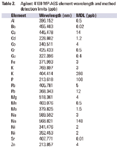
Table 2. Agilent 4100 MP-AES element wavelength and method detection limits (ppb)
ANALYSIS OF FOODSTUFFS
Results of the analysis of major, minor and trace extractable elements in six different foodstuffs are listed in Tables 3 to 8. The measured values (carried out in triplicate) are in good agreement with the certified values for all CRM and SRM samples.
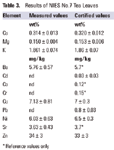
Table 3. Results of NIES No.7 Tea Leaves
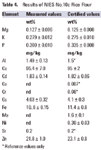
Table 4. Results of NIES No.10c Rice Flour
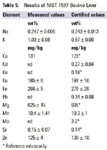
Table 5. Results of NIST 1577 Bovine Liver
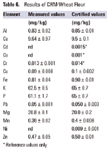
Table 6. Results of CRM-Wheat Flour
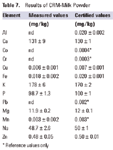
Table 7. Results of CRM-Milk Powder
CONCLUSIONS
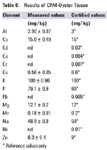
Table 8. Results of CRM-Oyster Tissue
MP-AES offers any food testing facilities dependent on acetylene-based instrumentation a real alternative in terms of sensitivity, multi-element capability, and speed of analysis, while cutting operating costs and improving the safety of the lab environment through the use of non-flammable nitrogen.
This study shows that following a quick and simple acid digestion sample preparation procedure (required for three of the six diverse food samples), all six certified and standard reference materials can be analyzed for trace and major element concentrations with good accuracy by MP-AES. The addition of the Agilent 4107 Nitrogen Generator is also possible in order to perform this analysis with significantly lower gas costs or for analysis in remote locations where sourcing of gases is costly or difficult.
Agilent shall not be liable for errors contained herein or for incidental or consequential damages in connection with the furnishing, performance, or use of this material. Information, descriptions, and specifications in this publication are subject to change without notice.
Analytical Challenges in Measuring Migration from Food Contact Materials
November 2nd 2015Food contact materials contain low molecular weight additives and processing aids which can migrate into foods leading to trace levels of contamination. Food safety is ensured through regulations, comprising compositional controls and migration limits, which present a significant analytical challenge to the food industry to ensure compliance and demonstrate due diligence. Of the various analytical approaches, LC-MS/MS has proved to be an essential tool in monitoring migration of target compounds into foods, and more sophisticated approaches such as LC-high resolution MS (Orbitrap) are being increasingly used for untargeted analysis to monitor non-intentionally added substances. This podcast will provide an overview to this area, illustrated with various applications showing current approaches being employed.


